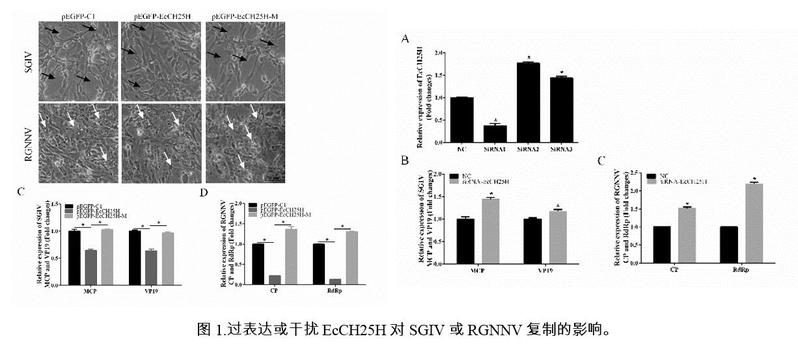Professor Qin Qiwei's team has achieved new results in the field of marine fish antiviral immunity research
Recently, the team of Professor Qin Qiwei of the Ocean Academy has made important progress in the study of antiviral immunity of marine fish, revealing the antiviral function and immunomodulatory mechanism of the metabolic immune related gene of grouper, Cholesterol 25 hydroxylase (CH25H) and autophagy related gene ATG5. The relevant research results were entitled Fish Cholesterol 25-Hydroxylase Inhibits Virus Replication via Regulating interferon immune response or Affect Ing Virus Entry. And Fish Autophagy Protein 5 Exerts Negative Regulation on Antiviral immune response Against Iridovirus and Nodavirus were published successively in the Frontiers in Immunology (JCR II, Impact factor 5.511).
(Paper Links: https://www.ncbi.nlm.nih.gov/pmc/articles/PMC6414437/pdf/fimmu-10-00322.pdf and https://www.ncbi.nlm.nih.gov/pmc/articles/PMC6433989/pdf/fimmu-10-00517.pdf). Grouper is an important mariculture fish in southern China and Southeast Asian countries and regions, and its economic value is extremely high. However, the frequent outbreak of disease seriously restricts the healthy and sustainable development of grouper breeding. Among them, the outbreak and prevalence of the iridescent virus and nerve necrosis virus in recent years is the most serious infectious viral pathogen. At present, the pathogenesis of the infection of grouper virus and the interaction between virus and host are still unclear, and there is a lack of effective coping strategies and prevention measures. Antiviral immunity is the body's immune response to viral infection, can effectively combat, contain, eliminate the virus on the body infection and destruction, is the body to adapt to the natural environment of the important guarantee.
Studying the role of grouper metabolism and immune gene in host antiviral immunity not only helps to elucidate the virus-host interaction, but also provides important theoretical information for the development of marine fish disease-resistant functional products. Cholesterol 25 hydroxylase (CH25H), a interferon stimulating gene that locates and endoplasmic reticulum, catalyzes the conversion of cholesterol to 25 hydroxyl cholesterol (25HC) to reduce cholesterol buildup. However, it is not known whether fish CH25H have antiviral functions. In this study, the researchers cloned and identified the CH25H congeners (EcCH25H) of grouper (Epinephelus coioides) and studied the mechanism of the gene's role in antiviral immunity. The results showed that EcCH25H and mutant EcCH25H-M were distributed in cytoplasm, and some were co-located with endoplasmic reticulum in cytoplasm. EcCH25H expression inhibits the replication of the Grouper iridescent virus SGIV and the RGNNV of the nerve necrosis virus (fig. 1). On the contrary, silent EcCH25H can facilitate the replication of viruses. EcCH25H expression is regulating the expression of interferon related molecules and inflammatory cytokines, enhancing the activity of interferon and ISRE reporting genes. In addition, the use of 25HC to treat cells significantly inhibits the entry of SGIV and RGNNV into host cells, and similar results are observed in EcCH25H expression cells (Fig. 2).


To sum up, EcCH25H inhibits viral replication by regulating interferon immune response or affecting virus entry. Autophagy is a life phenomenon in which eukaryotic organisms degrade intracellular components through lysosomes, with the aim of removing substances that are useless or harmful to cells and thus maintaining a stable internal environment. In higher mammals, a large number of autophagy related genes have been discovered and their functions have been studied preliminarily. However, little research has been reported on the genes associated with fish autophagy. The mechanism of fish ATG5 in antiviral immune response was reported for the first time in this study.

The results show that fish ATG5 promote the replication of fish viruses mainly by promoting autophagy, reducing antiviral interferon reactions and affecting cell cycles (Fig. 3). Zhangya, a PhD student at our School of Oceanography, and Li took advantage of the first authors of the two papers, Professor Huang Youhua and Professor Weiking respectively, and Professor Qin Qiwei as co-authors of the two papers. This study was funded by the Blue Blue Warehouse Technology Project (2018YFD0900505) of the National Key R & amp; d program and the Key Fund project (31330082) of the National Natural Science Foundation of the state. (Wen/fig. Huangxiaogong, Weiking, Huang Youhua, Ocean Academy)



